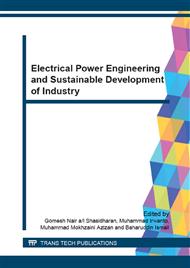[1]
J. R. Espinoza, G. Joos, J. I. Guzman, L. A. Moran, and R. P. Burgos, Selective harmonic elimination and current/voltage control in current/voltage-source topologies: a unified approach, Industrial Electronics, IEEE Transactions on, vol. 48, pp.71-81, (2001).
DOI: 10.1109/41.904556
Google Scholar
[2]
J. I. Guzman, J. R. Espinoza, L. A. Moran, and G. Joos, Selective Harmonic Elimination in Multimodule Three-Phase Current-Source Converters, Power Electronics, IEEE Transactions on, vol. 25, pp.44-53, (2010).
DOI: 10.1109/tpel.2009.2023658
Google Scholar
[3]
H. F. Bilgin and M. Ermis, Design and Implementation of a Current-Source Converter for Use in Industry Applications of D-STATCOM, Power Electronics, IEEE Transactions on, vol. 25, pp.1943-1957, (2010).
DOI: 10.1109/tpel.2010.2043958
Google Scholar
[4]
L. Yun Wei, M. Pande, N. R. Zargari, and W. Bin, An Input Power Factor Control Strategy for High-Power Current-Source Induction Motor Drive With Active Front-End, Power Electronics, IEEE Transactions on, vol. 25, pp.352-359, (2010).
DOI: 10.1109/tpel.2009.2028344
Google Scholar
[5]
J. R. Espinoza and G. Joos, Current-source converter on-line pattern generator switching frequency minimization, Industrial Electronics, IEEE Transactions on, vol. 44, pp.198-206, (1997).
DOI: 10.1109/41.564158
Google Scholar
[6]
Suroso and T. Noguchi, Common-emitter topology of multilevel current-source pulse width modulation inverter with chopper-based dc current sources, Power Electronics, IET, vol. 4, pp.759-766, (2011).
DOI: 10.1049/iet-pel.2010.0008
Google Scholar
[7]
S. Suroso and T. Noguchi, Multilevel Current Waveform Generation Using Inductor Cells and H-Bridge Current-Source Inverter, Power Electronics, IEEE Transactions on, vol. 27, pp.1090-1098, (2012).
DOI: 10.1109/tpel.2010.2056933
Google Scholar
[8]
D. N. Zmood and D. G. Holmes, A generalised approach to the modulation of current source inverters, in Power Electronics Specialists Conference, 1998. PESC 98 Record. 29th Annual IEEE, 1998, pp.739-745 vol. 1.
DOI: 10.1109/pesc.1998.701981
Google Scholar
[9]
L. Yun Wei, W. Bin, D. Xu, and N. R. Zargari, Space Vector Sequence Investigation and Synchronization Methods for Active Front-End Rectifiers in High-Power Current-Source Drives, Industrial Electronics, IEEE Transactions on, vol. 55, pp.1022-1034, (2008).
DOI: 10.1109/tie.2008.917073
Google Scholar
[10]
L. Lopes and M. F. Naguib, Space Vector Modulation for Low Switching Frequency Current Source Converters With Reduced Low-Order Noncharacteristic Harmonics, Power Electronics, IEEE Transactions on, vol. 24, pp.903-910, (2009).
DOI: 10.1109/tpel.2008.2011270
Google Scholar
[11]
M. F. Naguib and L. Lopes, Minimize Low-Order Harmonics in Low-Switching-Frequency Space-Vector-Modulated Current Source Converters With Minimum Harmonic Tracking Technique, Power Electronics, IEEE Transactions on, vol. 24, pp.881-893, (2009).
DOI: 10.1109/tpel.2008.2009055
Google Scholar
[12]
D. Jingya, L. Yongqiang, W. Bin, X. Dewei, and N. R. Zargari, A Multisampling SVM Scheme for Current Source Converters With Superior Harmonic Performance, Power Electronics, IEEE Transactions on, vol. 24, pp.2436-2445, (2009).
DOI: 10.1109/tpel.2009.2030808
Google Scholar
[13]
B. Mirafzal, M. Saghaleini, and A. K. Kaviani, An SVPWM-Based Switching Pattern for Stand-Alone and Grid-Connected Three-Phase Single-Stage Boost Inverters, Power Electronics, IEEE Transactions on, vol. 26, pp.1102-1111, (2011).
DOI: 10.1109/tpel.2010.2089806
Google Scholar
[14]
S. Azmi, G. Adam, K. Ahmed, S. Finney, and B. Williams, Grid Interfacing of Multi-Megawatt Photovoltaic Inverters, Power Electronics, IEEE Transactions on, vol. PP, pp.1-1, (2012).
DOI: 10.1109/tpel.2012.2219072
Google Scholar
[15]
M. A. Boost and P. D. Ziogas, State-of-the-art carrier PWM techniques: a critical evaluation, Industry Applications, IEEE Transactions on, vol. 24, pp.271-280, (1988).
DOI: 10.1109/28.2867
Google Scholar


